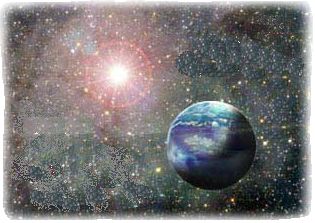
SPACE TODAY ONLINE — COVERING SPACE FROM EARTH TO THE EDGE OF THE UNIVERSE
Cover | Deep Space | Solar System | Rockets | Satellites | Shuttles | Stations | Astronauts | History | Global Links | Search
Doubling the number of exoplanets:
Hubble Finds 100 Planets At Other Stars
A vast sweep of thousands of stars in the sky in February 2004 by the Hubble Space Telescope, orbiting above Earth's atmosphere, turned up as many as 100 new planets near stars elsewhere in the Milky Way. If the finds are confirmed by the astronomy community, the number of exoplanets will be almost doubled. That shows that solar systems are not unusual.
NASA concept of an extrasolar terrestrial planet
The planets were found during seven days of observations by Hubble astronomer Kailash Sahu of the Space Telescope Science Institute in Baltimore.
Astronomers suspect that most most stars in our Milky Way galaxy are surrounded by a system of one or more planets. If that were true, it would increase the likelihood that life could exist beyond Earth.
Less sweeping searches since 1995 have turned up about 100 exoplanets.
Stars and planets...
A disk of dust swirls around a new-born star. Over a very long period of time, the mutual gravity of the specks of dust pulls them together and condenses them into larger and larger rocks. Large rocks are called planetesimals. The countless planetesimals forming in the dust disk smash into each other -- like a cosmic demolition derby -- shattering and re-condensing until they are hot enough to melt together into a few very large planet-sized globules. As the infant star ignites in nuclear burning, its brisk wind of radiation blows away most of the remaining dust in the disk, leaving the planets alone to cool and solidify.
Even with the most modern astronomy equipment, detection of distant planets beyond our Solar System is very difficult. Stars are millions of times bigger and brighter than the tiny globes that circle them, washing out our view of any planets which might be there.
False alarms in the 1980s and early 1990s soured the reputation of planet hunting. However, technological advances in the 1990s changed the picture. There has been a renaissance in the search for planets as astronomers have acquired both better telescopes and better understanding of how planets behave as they circle the mighty powerhouses that we call stars.
Exoplanets...
Astronomers coined the terms "extra-solar planet" and "exoplanet" to distinguish those planets found circling distant stars from the nine planets that circle our star, the Sun.
Previously found exoplanets...
Astronomers could just feel it in their bones. There had to be other stars, beyond our own Sun, with planets in orbit around them. But, they couldn't find any until 1995.
That year, in October, astronomers at Switzerland's Geneva Observatory, Michel Mayor and Didier Queloz, found an extra-solar planet orbiting the distant star 51 Pegasi. Mayor and Queloz knew it was orbiting out there because they watched it over a long period of time and observed that the star was moving slightly toward and away from Earth every four days. That told them the star was affected by the gravitational tug of an unseen planet orbiting around it.
Today's telescope technology does not allow astronomers to see distant planets directly. Rather, they find small shifts in the movements of stars that reveal the presence of unseen planets. As a star tugs on a planet and holds it in orbit, the planet tugs back on the star, affecting the star's orbit. Of course the star far outweighs the planet, so the star barely changes its position.
Learn more:
- Hubble Space Telescope
- Extrasolar Planets Encyclopaedia
- The Search for the Extrasolar Planets: A Brief History of the Search, the Findings and the Future Implications
- Hunting Planets Along the Milky Way
- Future American and European Planet Finding Missions
- Is That Tiny Dot a Planet?
- Planet Construction Zone at Nearby Star
- Planet Seen Outside Our Solar System
- NASA's Origins Program
- Where did we come from? Are we alone?
- Lightyears
- NASA JPL Planet Quest
- NASA JPL Terrestrial Planet Finder
Planet Hunters Mysteries of Deep Space Deep Space index Top of this page Search STO STO cover Copyright 2004 Space Today Online
